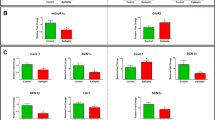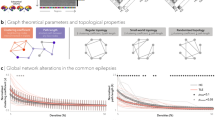Abstract
The concentration of free amino acids was measured in 41 surgically removed samples of human epileptogenic brain and in 7 specimens of non-epileptic brain tissue, removed during surgery for meningiomas, etc. The material was subdivided according to the neuropathological diagnosis: mild cortical dysplasia (MCD), gliosis astrocytoma infiltration and a histologically heterogeneous group. The non-tumoral epileptogenic samples had five times higher than normal concentration of ethanolamine and 50% elevated concentration of glycine. The concentration of other neurotransmitter amino acids did not differ markedly between epileptogenic and non-epileptic samples. The concentration of neurotransmitter amino acids showed a strong correlation with the enzyme neuron specific enolase (NSE) and were low in most samples with astrocytoma infiltration. On the other hand, tyrosine and leucine had higher concentrations in samples with lower NSE concentration. Factor analysis of the amino acids revealed four groups of covarying compounds in the brain samples, first, a neurotransmitter group, including aspartate, glutamate, GABA and phosphoethanolamine. Another group contained ethanolamine, glutamine, glycine and taurine. Factor analysis on corresponding extracellular amino acids showed two groups, the first being a “neurotransmitter” group, containing serine, taurine phosphoethanolamine and ethanolamine in addition to aspartate and glutamate. The other group consisted of asparagine, glycine, alanine, tyrosine, valine, phenylalanine, isoleucine and leucine.
Similar content being viewed by others
References
Johnson, J. W., and Ascher, P. 1987. Glycine potentiates the NMDA response in cultured mouse brain neurons. Nature 325:529–531.
Meldrum, B. 1984. Amino acid neurotransmitters and new approaches to anticonvulsant drug action. Epilepsia 25:140–149.
Browne, T. R., Mattson, R., Pendry, J. K., Smith, D. B., Treiman, D. M., Wilder, B. J., Ben-Menachem, E., Miketta, R. M., Sherry, K. M., and Szabo, G. K. 1989. A multicentre study of vigabatrin for drug-resistant epilepsy. Br. J. Clin. Pharmac. 27:95S-100S.
Perry, T., and Hansen, S. 1981. Amino acid abnormalities in epileptogenic foci. Neurology 31:872–876.
Sherwin, A. L., and van Gelder, N. M. 1986. Amino acid and catecholamine markers of metabolic abnormalities in human focal epilepsy. Advances in Neurology 44:1011–1032. Raven Press, New York.
Sherwin, A., Robitaille, Y., and Quesney, F., et al., 1988. Excitatory amino acids are elevated in human epileptic cerebral cortex. Neurology 38:920–923.
Hamberger, A., Nyström, B., Larsson, S., Silfvenius, H., and Nordborg, C. 1991. Amino acids in the neuronal microenvironment of focal human epileptic lesions. Epilopsy Res. 9:32–43.
Hamberger, A., Nordborg, C., Nyström, B., Silfvenius, H., Wang, S., and Haglid, K. 1993. Biochemical correlates to cortical dysplasia, gliosis and astrocytoma infiltration in human epileptogenic cortex. Neurochem Res. 18:511–518.
Lindroth, P., and Mopper, K. 1979. High performance liquid chromatographic determination of subpicomole amounts of amino acids by precolumn fluorescence derivatization with ophtaldialdehyde. Analyt. Chem. 51:1667–1674.
Wang, S., Lees, G. J., Rosengren, L. E., Karlsson, J.-E., Stigbrand, T., Hamberger, A., and Haglid, K. G. 1991. The effect of an N-methyl-D-aspartate lesion in the hippocampus on glial and neuronal marker proteins. Brain Res. 541:334–341.
Perry, T. 1982. Cerebral amino acid pools. In Lajtha A (ed): “Handbook of Neurochemistry” vol 1, Plenum Press, New York, pp. 151–180.
van Gelder, N. M., Sherwin, A. L., and Rasmussen, T. 1972. Amino acid content of epileptogenic human brain: focal versus surrounding regions. Brain Res. 385–403.
Koyama, I. 1978. Amino acid concentration in the brain of a cat with spontaneous chronic epilepsy. J. Tokoyo Women's Med. Coll. 48:428–431.
Wasterlain, C. G., Morin, A. M., and Dwyer, B. E. 1985. The Epilepsies. In Lajtha, A. (ed.): “Handbook of Neurochemistry”, vol 10, Plenum Press, New York, pp. 339–419.
Porcellati, G., and Arienti, G. 1983. Metabolism of phosphoglycerides. Pages 133–161.in Lajtha, A. (ed): Handbook of Neurochemistry, vol 3, Plenum Press, New York.
Binaglia, L., Goracci, G., Porcellati, G., Roberti, R., and Woelk, H. 1973. The synthesis of choline and ethanolamine phosphoglycerides in neuronal and glial cells of rabbit in vitro. J. Neurochem. 21:1067–1082.
Lehmann, A., Hagberg, H., Jacobson, I., and Hamberger, A. 1985. Effect of status epilepticus on extracellular amino acids in the hippocampus. Brain Res. 359:147–151.
Hagberg, H., Lehmann, A., Sandberg, M., Nyström, B., Jacobson, I., and Hamberger, A. 1985. Ischemia-induced shift of inhibitory and excitatory amino acids from intra-to extracellular compartments. J. Cereb. Blood Flow Metab. 5:413–419.
Lehmann, A., Laird, H. E., Huxtable, R. J. 1986. Electroencephalographic effects of centrally administered phosphoenthanolamine and glutaminc acid. Proc. West Pharmacol. Soc. 29:227–231.
Zeise, M., Lehmann, A. 1987. Phosphoethanolamine transiently enhances excitability of rat hippocampal neurons in vitro. J. Comp. Physiol. A. 161:461–467.
Author information
Authors and Affiliations
Additional information
Special issue dedicated to Dr. Claude Baxter.
Rights and permissions
About this article
Cite this article
Hamberger, A., Haglid, K., Nyström, B. et al. Co-variation of free amino acids in human epileptogenic cortex. Neurochem Res 18, 519–525 (1993). https://doi.org/10.1007/BF00967256
Accepted:
Issue Date:
DOI: https://doi.org/10.1007/BF00967256




